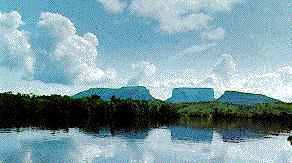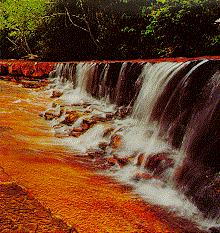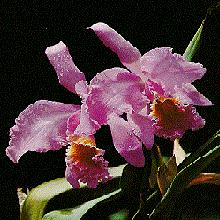Canaima
This page was developed by the Venezuelan Embassy in Japan
Canaima National Park was decreed as such by the National Government on June 12th, 1962, with an area of one million hectares (1,000,00 Ha), which was increased to three million hectares on October 10th, 1975, making it one of the largest national parks in the world.
The park is located in Venezuela's Guayana region, south of the Orinoco River, in the Gran Sabana Autonomous Municipality and the Sifontes Municipality of Bolívar State.
Scenery
 By its very size and because of its spectacular scenery and vast natural resources, Canaima National Park is truly one of the world's greatest natural wonders. It is crossed by huge rapids as well as slow, majestic rivers, which flow in marked contrast to thick jungle of this paradise, reflecting the variety of green hues as they blend with the water. In the plains, the rivers weave across the open grasslands, interrupting their course at any of the many indescribable waterfalls that are a common feature of Guayana.
By its very size and because of its spectacular scenery and vast natural resources, Canaima National Park is truly one of the world's greatest natural wonders. It is crossed by huge rapids as well as slow, majestic rivers, which flow in marked contrast to thick jungle of this paradise, reflecting the variety of green hues as they blend with the water. In the plains, the rivers weave across the open grasslands, interrupting their course at any of the many indescribable waterfalls that are a common feature of Guayana.
 The rolling scenery meets the legendary "tepuys" (table-top mountains), transporting the spectator back over thousands of years and showing the Earth's physiochronology as if in an open book. Exuberant wildlife and flowers join in a polychromatic concert of living beings, with intense colour and light in harmonious natural surroundings. This daily spectacle includes jungles, forest, grasslands, mountains, strong winds and torrential rains, which give way to wide, blue skies.
The rolling scenery meets the legendary "tepuys" (table-top mountains), transporting the spectator back over thousands of years and showing the Earth's physiochronology as if in an open book. Exuberant wildlife and flowers join in a polychromatic concert of living beings, with intense colour and light in harmonious natural surroundings. This daily spectacle includes jungles, forest, grasslands, mountains, strong winds and torrential rains, which give way to wide, blue skies.
Relief
Canaima National Park has valleys as low as 400m above sea level, while some 'tepuys' rise to over 2,400m above sea level. Roraima, for example, has an altitude of 2,763m at its table-top.
Geology
The most ancient rock formations in the world's geochronology are found here. Dating from the Precambrian period, they are assumed to have been formed between 1,5 million and 2 billion years ago. These rock formations belong to the Guayana Shield; stratigraphically, they belong to the Roraima Province Formation.
Climate
 Most of the Canaima National Park falls under the influence of an Equatorial Climate, with sunshine and high precipitations throughout the year. Some areas have an average anual precipitation of 1,500 to 2,000mm, while higher areas may have up to 4,000mm per year. The park's average temperature is 10 to 20 degrees centigrade, depending on the altitude, type of area and season. At the top of some tepuys temperatures of near 0 degrees centigrade have been registered. The dry season lasts from January to March, and the rainy season lasts from April to December.
Most of the Canaima National Park falls under the influence of an Equatorial Climate, with sunshine and high precipitations throughout the year. Some areas have an average anual precipitation of 1,500 to 2,000mm, while higher areas may have up to 4,000mm per year. The park's average temperature is 10 to 20 degrees centigrade, depending on the altitude, type of area and season. At the top of some tepuys temperatures of near 0 degrees centigrade have been registered. The dry season lasts from January to March, and the rainy season lasts from April to December.
Tepuys
 Among the main features in Canaima National Park, we find the tepuys with their vertical walls carved by the erosion of millions of years. Tepuy walls are composed of polychrome sandstone, quartz and agglomearates, which emerge abruptly out of the grasslands and thick jungles.
Among the main features in Canaima National Park, we find the tepuys with their vertical walls carved by the erosion of millions of years. Tepuy walls are composed of polychrome sandstone, quartz and agglomearates, which emerge abruptly out of the grasslands and thick jungles.
Tepuys have flat, slightly sloping tops, where plant life is endemic. Writers have termed the table-tops "islands in time" or "ecological islands".
The very particularities of these mountains, above all the plant life at the table-tops, makes these ecosystems unique in the world. Rising up through the clouds, the beholder cannot help but feel he is travelling back in time.
Principal rivers
The main rivers that cross Canaima National Park are the Caroni, Carrao, Aponwao, Kukenan, Churun, Arabopo, Yuruani, Kauai, Cucurital, Tirika, Urimank Aranan, Kamoirank Apakara, Aprado, Aravak, Mauruk, Surukun, Kerepakupai, Tek Luana, Arauriquenk Antabare, and Karaurin, many of which are navigable throughout the year; others are only navigable during the rainy season.
Main Waterfalls
 Among the Park's main features we find its waterfalls, known as meru or vena in the Pemon language. the most important ones are Angel Falls or Parecupa-vena, Kerepakupai-meru, Churun-meru, Hacha or Kama-meru, Chinak-meru, Aponwao Toron-meru, Kukenan, El Danto, Aripichi, Eurobarima, La Cortina or Aicha-meru, Epopa, Techinen-meru, Yunwaru-meru and El Sapo.
Among the Park's main features we find its waterfalls, known as meru or vena in the Pemon language. the most important ones are Angel Falls or Parecupa-vena, Kerepakupai-meru, Churun-meru, Hacha or Kama-meru, Chinak-meru, Aponwao Toron-meru, Kukenan, El Danto, Aripichi, Eurobarima, La Cortina or Aicha-meru, Epopa, Techinen-meru, Yunwaru-meru and El Sapo.
Wildlife
the park's wildlife is extremely diverse, depending on such factors as altitude, type of plant life and productivity of the ecosystems. The most commonly found vertebrates are the following:
Mammals
Collared anteater, tapir, paca, wgitw-lipped peccary, agouti, puma, common opossums, guianan squirrels, red bracket deer, three-toed sloth, crab eating fox, long tailed weasel, bushdog, brown capuchin monkey, howler monky, night monkey.
Birds
 Red and green Macaw, Red billed Macaw, fiery-shouldered Parakeets, Brown-throated Parakeets, King Vulture, Paradise Tanager, White Bellbird, Guianan Cock of the Rock, Musician Wren, Great Kiskadee, Bananaquit, Velvet Browned Brillant, Capunchinbird, sooty-capped Hermit, Blue-cheeked Parrot and others.
Red and green Macaw, Red billed Macaw, fiery-shouldered Parakeets, Brown-throated Parakeets, King Vulture, Paradise Tanager, White Bellbird, Guianan Cock of the Rock, Musician Wren, Great Kiskadee, Bananaquit, Velvet Browned Brillant, Capunchinbird, sooty-capped Hermit, Blue-cheeked Parrot and others.
Reptiles
Anolis auratus, Paleosuchus trigonatus, iguanas, Geochelone denticulata, Tropidurus torquatus.
Plant Life
the varied climate, different altitudes, and geographical diversity have produced exuberant vegetation in Canaima National park. The most characteristic elements in the park are forests and grasslands, but gallery forests along the rivers, grasslands spotted with mirity palms and tepuy vegetation are also plentiful.
A map of the Venezuelan vegetation would necessarily show high altitude evergreeen forests, cloudy forests, lower mountain forests and evergreen forests downsloping towards the base, open grasslands, grasslands with mirity palm areas, lower tepuy bushes and high, table top vegetation.
Flowers
 The jungles and forests of Canaima National Park contain many heterogeneous flowers, including innumerable orchids and bromelias. Many of the plants that grow on the top of the tepuys are found nowhere else on the planet and many of them are endemic to some particular tepuy. Among the more interesting flora are carnivorous plants that trap insects to complement their dietary nutrients.
The jungles and forests of Canaima National Park contain many heterogeneous flowers, including innumerable orchids and bromelias. Many of the plants that grow on the top of the tepuys are found nowhere else on the planet and many of them are endemic to some particular tepuy. Among the more interesting flora are carnivorous plants that trap insects to complement their dietary nutrients.
Native Indian Communities
Indian communitites in Canaima National Park are ethnically Pemon, belonging to the Arekuna, Taurepane and Kamaracoto families. Nearby, west of the National Park live the Yekuana of Maquiritate Indians. The original inhabitants of these lands were the Pemon Indians, for whom the word pemon means people. Their view of the cosmos, their relationships and perception of nature, was well as their system of social organization, compose a culture deserving interest and consideration.
Tourist Attractions:
- Laguna de Canaima
- Salto Hacha (waterfall)
- Salto El Sapo (waterfall)
- Carrao River
- Mayupa rapids
- Salto Yuri (waterfall)
- Cucurital River jungle and grasslands
- Isla de la Orquìdea (orchid Island)
- Churún River
- Angel Falls
- Kavac
- Kamarata
Tourists can travel to these sites by air, departing from Maiquetía, Ciudad Bolìvar, Puerto Ordaz, and Margarita. The camps are well built and provide lodging and meals. It is possible to take excursions by river or go by plane into nearby areas.
It is recommended that you:
- Respect the wildlife and its habitat
- Follow the signs along the path - remember that you are visiting extremely fragile ecosystems
- Learn about Canaima National Park before visiting; register with the forest rangers' post and follow their advice
- Present sound contamination; carry no radios or sound equipment that may disturb the peace in the park
- Respect the culture and customs of the Native Indians
- Carry a first aid kit and insect repellent
- Do not contaminate the rivers; use only soaps with low detergent levels.
- Prevent forest fires; take every precaution necessary
photographs
Román Rangel
Fundación Banco Consolidado
Fundación Canaima
 Return
Return
 The rolling scenery meets the legendary "tepuys" (table-top mountains), transporting the spectator back over thousands of years and showing the Earth's physiochronology as if in an open book. Exuberant wildlife and flowers join in a polychromatic concert of living beings, with intense colour and light in harmonious natural surroundings. This daily spectacle includes jungles, forest, grasslands, mountains, strong winds and torrential rains, which give way to wide, blue skies.
The rolling scenery meets the legendary "tepuys" (table-top mountains), transporting the spectator back over thousands of years and showing the Earth's physiochronology as if in an open book. Exuberant wildlife and flowers join in a polychromatic concert of living beings, with intense colour and light in harmonious natural surroundings. This daily spectacle includes jungles, forest, grasslands, mountains, strong winds and torrential rains, which give way to wide, blue skies.
 By its very size and because of its spectacular scenery and vast natural resources, Canaima National Park is truly one of the world's greatest natural wonders. It is crossed by huge rapids as well as slow, majestic rivers, which flow in marked contrast to thick jungle of this paradise, reflecting the variety of green hues as they blend with the water. In the plains, the rivers weave across the open grasslands, interrupting their course at any of the many indescribable waterfalls that are a common feature of Guayana.
By its very size and because of its spectacular scenery and vast natural resources, Canaima National Park is truly one of the world's greatest natural wonders. It is crossed by huge rapids as well as slow, majestic rivers, which flow in marked contrast to thick jungle of this paradise, reflecting the variety of green hues as they blend with the water. In the plains, the rivers weave across the open grasslands, interrupting their course at any of the many indescribable waterfalls that are a common feature of Guayana.
 Most of the Canaima National Park falls under the influence of an Equatorial Climate, with sunshine and high precipitations throughout the year. Some areas have an average anual precipitation of 1,500 to 2,000mm, while higher areas may have up to 4,000mm per year. The park's average temperature is 10 to 20 degrees centigrade, depending on the altitude, type of area and season. At the top of some tepuys temperatures of near 0 degrees centigrade have been registered. The dry season lasts from January to March, and the rainy season lasts from April to December.
Most of the Canaima National Park falls under the influence of an Equatorial Climate, with sunshine and high precipitations throughout the year. Some areas have an average anual precipitation of 1,500 to 2,000mm, while higher areas may have up to 4,000mm per year. The park's average temperature is 10 to 20 degrees centigrade, depending on the altitude, type of area and season. At the top of some tepuys temperatures of near 0 degrees centigrade have been registered. The dry season lasts from January to March, and the rainy season lasts from April to December.
 Among the main features in Canaima National Park, we find the tepuys with their vertical walls carved by the erosion of millions of years. Tepuy walls are composed of polychrome sandstone, quartz and agglomearates, which emerge abruptly out of the grasslands and thick jungles.
Among the main features in Canaima National Park, we find the tepuys with their vertical walls carved by the erosion of millions of years. Tepuy walls are composed of polychrome sandstone, quartz and agglomearates, which emerge abruptly out of the grasslands and thick jungles.
 Among the Park's main features we find its waterfalls, known as meru or vena in the Pemon language. the most important ones are Angel Falls or Parecupa-vena, Kerepakupai-meru, Churun-meru, Hacha or Kama-meru, Chinak-meru, Aponwao Toron-meru, Kukenan, El Danto, Aripichi, Eurobarima, La Cortina or Aicha-meru, Epopa, Techinen-meru, Yunwaru-meru and El Sapo.
Among the Park's main features we find its waterfalls, known as meru or vena in the Pemon language. the most important ones are Angel Falls or Parecupa-vena, Kerepakupai-meru, Churun-meru, Hacha or Kama-meru, Chinak-meru, Aponwao Toron-meru, Kukenan, El Danto, Aripichi, Eurobarima, La Cortina or Aicha-meru, Epopa, Techinen-meru, Yunwaru-meru and El Sapo.
 Red and green Macaw, Red billed Macaw, fiery-shouldered Parakeets, Brown-throated Parakeets, King Vulture, Paradise Tanager, White Bellbird, Guianan Cock of the Rock, Musician Wren, Great Kiskadee, Bananaquit, Velvet Browned Brillant, Capunchinbird, sooty-capped Hermit, Blue-cheeked Parrot and others.
Red and green Macaw, Red billed Macaw, fiery-shouldered Parakeets, Brown-throated Parakeets, King Vulture, Paradise Tanager, White Bellbird, Guianan Cock of the Rock, Musician Wren, Great Kiskadee, Bananaquit, Velvet Browned Brillant, Capunchinbird, sooty-capped Hermit, Blue-cheeked Parrot and others.
 The jungles and forests of Canaima National Park contain many heterogeneous flowers, including innumerable orchids and bromelias. Many of the plants that grow on the top of the tepuys are found nowhere else on the planet and many of them are endemic to some particular tepuy. Among the more interesting flora are carnivorous plants that trap insects to complement their dietary nutrients.
The jungles and forests of Canaima National Park contain many heterogeneous flowers, including innumerable orchids and bromelias. Many of the plants that grow on the top of the tepuys are found nowhere else on the planet and many of them are endemic to some particular tepuy. Among the more interesting flora are carnivorous plants that trap insects to complement their dietary nutrients.
